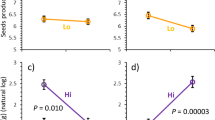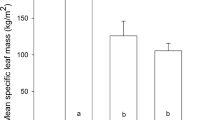Summary
A hypothesis is put forward that the long-lasting inducible responses of trees to herbivores, particularly lepidopteran defoliators, may not be active defensive responses, but a by-product of mechanisms which rearrange the plant carbon/nutrient balance in response to nutrient stress caused by defoliation. When defoliation removes the foliage nutrients of trees growing in nutrient-poor soils, it increases nutrient stress wich in turn results in a high production of carbon-based allelochemicals. The excess of carbon that cannot be diverted to growth due to nutrient stress is diverted to the production of plant secondary metabolites. The level of carbon-based secondary substances decays gradually depending on the rate at which nutrient stress is relaxed after defoliation. In nutrient-poor soils and in plant species with slow compensatory nutrient uptake rates the responses induced by defoliation can have relaxation times of several years. The changes in leaf nitrogen and phenolic content of mountain birch support this nutrient stress hypothesis. Defoliation reduces leaf nitrogen content while phenolic content increases. These responses of mountain birch to defoliation are relaxed within 3–4 years.
Similar content being viewed by others
References
Benz G (1974) Negative Rückkoppelung durch Raum-und Nahrungkonkurrenz sowie zyklische Veränderung der Nahrungsgrundlage als Regelprinzip in der Populationsdynamik des Grauen Lärchenwicklers, Zeiraphera diniana (Guenée) (Lep., Tortricidae). Z angew Ent 76:196–228
Bernays EA (1981) Plant tannins and insect herbivores: an appraisal. Ecol Ent 6:353–360
Bryant JP, Chapin FS III, Klein DR (1983) Carbon/nutrient balance of boreal plants in relation to vertebrate herbivory. Oikos 40:357–368
Chew FS, Rodman JB (1979) Plant resources for chemical defence. In Rosenthal GA, Janzen DH (eds) Herbivores. Their interaction with secondary plant metabolites, pp 271–303. Academic Press New York
Feeny PP (1968) Effect of oak leaf tannins on larval growth of the winter moth Operophtera brumata. J Insect Physiol 14:805–817
Harper JL (1977) Population biology of plants. Academic Press London
Haukioja E (1982) Inducible defences of white birch to a geometrid defoliator, Epirrita autumnata. Proc 5th Int Symp Insect-Plant Relationships Wageningen 1982, pp 199–203. Pudoc Wageningen
Haukioja E, Niemelä P, Iso-Iivari L, Sirén S, Kapiainen K, Laine KJ, Hanhimäki S, Jokinen M (1981) Koivun merkitys tunturimittarin kannanvaihtelussa. (Defence mechanisms in birches and fluctuation of autumnal moth populations.) Luonnon Tutkija 85:127–140 (in Finnish)
Hinneri S (1974) Podzolic processes and bioelement pools in subarctic forest soils at the Kevo Station, Finnish Lapland. Rep Kevo Subarctic Res Stat 11:26–34
Lincoln DE, Newton TS, Ehrlich PR, Williams KS (1982) Coevolution of the checkerspot butterfly Euphydryas chalcedona and its larval food plant Diplacus aurantiacus: Larval response to protein and leaf resin. Oecologia (Berlin) 52:216–223
Mattson WJ (1980) Herbivory in relation to plant nitrogen content. Ann Rev Ecol Syst 11:119–161
Myers JH (1981) Interactions between western tent caterpillars and wild rose: a test of some general plant herbivore hypotheses. J Anim Ecol 50:11–25
Ryan CA, Green TR (1974) Proteinase inhibitors in natural plant protection. Recent Adv Phytochem 8:123–140
Schultz JC, Baldwin IT (1982) Oak leaf quality declines in response to defoliation by Gypsy moth larvae. Science 217:149–151
Wallner WE, Walton GS (1979) Host defoliation: a possible determinant of Gypsy moth population quality. Ann Ent Soc Am 76:62–67
Werner RA (1979) Influence of host foliage on development, survival, fecundity and oviposition of the spear-marked moth Rheumaptera hastata (Lepidoptera, Geometridae). Can Ent 111:317–322
Author information
Authors and Affiliations
Rights and permissions
About this article
Cite this article
Tuomi, J., Niemelä, P., Haukioja, E. et al. Nutrient stress: an explanation for plant anti-herbivore responses to defoliation. Oecologia 61, 208–210 (1984). https://doi.org/10.1007/BF00396762
Received:
Issue Date:
DOI: https://doi.org/10.1007/BF00396762




